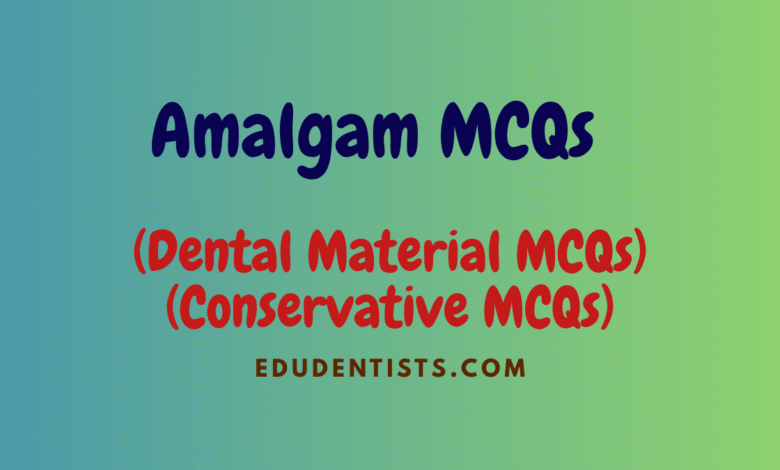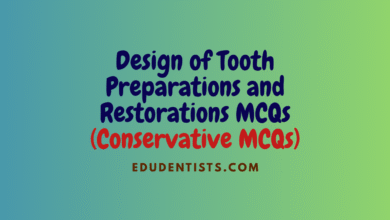Conservative Dentistry MCQsDental Materials MCQs
Amalgam MCQs _ Operative MCQs _ Dental Material MCQs

Amalgam MCQs _ Operative MCQs _ Dental Material MCQs
- Amalgam restorations give the best clinical service when the residual mercury content is?
A. 38-42%
B. 48-52%
C. 58-62%
D. 68-72% - Percentage of tin in low copper alloy is?
A. 30-35%
B. 26-28%
C. 13-32%
D. 22-30% - Cause of expansion in zinc containing amalgam is?
A. Zinc and water
B. Water
C. Hydrogen
D. Nascent oxygen - What is common in amalgam and ceramics?
A. More compressive strength but less tensile strength
B. More compressive strength and tensile strength
C. Less compressive strength but more tensile strength
D. Less compressive strength and tensile strength - Which of the following constituents of amalgam alloy decreases expansion?
A. Copper
B. Zinc
C. Silver
D. Tin - The higher the Hg alloy ratio in dental amalgam?
A. Higher the strength
B. Lower the creep value
C. More matrix matrial formed
D. More gamma 1 phase formed - Ag-Cu eutectic alloy has a characteristic Property of that fusion temp of?
A. The resultant alloy is greater
B. The resultant alloy is lesser
C. The resultant alloy varies according to the content of Ag of Cu
D. None of the above - What is the recommended for condensation of dental amalgam?
A. 35 pounds
B. 3 pounds
C. 15 lb
D. 25 lb - Which is not true about high copper amalgam alloys?
A. Low tensile and compressive strength
B. Low Hg: Alloy ratio
C. High tensile strength
D. Low creep - Amalgam means?
A. A metallic powder composed of silver, tin, copper and zinc
B. An alloy of two or more metals one of which is mercury
C. An alloy of two or more metals that have been dissolved in each other in the molten state
D. A metallic substances in powder or tablet from that is mixed with mercury - Dynamic creep is the:
A. Continuing alloying between silver-tin alloy and mercury during the life of restoration
B. Deformation of set amalgam during function
C. Process whereby alloy is wetted by murcury
D. Spread of amalgam during packing - The dental amalgam is most resistant to:
A. Compressive stress
B. Impact stress
C. Shear stress
D. Tensile stress - According of ADA specification No or number 1, the minimum compressive strength for silver amalgam filling aftr one hour should be:
A. 80 Mpa
B. 140 Mpa
C. 260 Mpa
D. 510 Mpa - Admixed high copper alloy powder contains:
A. 9-20% copper
B. 13-20% copper
C. 9-30% copper
D. 13-30% copper - Finishing and polishing of Amalgam make the restoration:
A. Increase in tarnish and corrosion resistance
B. Increase the marginal strength
C. Decrease the tarnish and corrosion resistance
D. Increased compressive strength - Setting time of Amalgam is best controlled by:
A. Using spherical particles
B. Lathe cut alloy
C. Altering Hg-Alloy ratio
D. Trituration time - In non zinc containing dental amalgam alloy the percentage of zinc present is:
A. Less than 0.02%
B. Less than 0.1%
C. Less than 0.01%
D. None of the above. - High copper dental amalgams are superior to other amalgams because high copper dental amalgams:
A. Have less marginal breakdown
B. Are workable at lower Hg-alloy ratio
C. Have a higher ratio of tensile to compressive strength
D. Have less resistance to tarnish and corrosion - The largest component of amalgam alloy is:
A. Silver
B. Tin
C. Zinc
D. Copper - During amalgamation, trituration is done to:
A. Dissolve the alloy in mercury
B. Coat the alloy particle with mercury
C. Remove excess mercury from the amalgam
D. Dissolve Hg in alloy - In amalgam alloy which acts as oxygen scavenger:
A. Cu
B. Zn
C. Pd
D. Ag - By increasing the percentage of which metal, the strength and hardness of amalgam increases:
A. Ag
B. Zn
C. Cu
D. Hg - Which of the following statement is true regarding lathe cut low Copper silver alloy:
A. Requires least amount of mercury
B. Achieves high compressive strength at 1 hr.
C. Has tensile strength both at 15 minutes and 7 days is comparable to high copper, unicompositional alloys
D. Has lower cree value - Creep value of which of the following is the highest:
A. Low copper amalgam alloy
B. Admix alloy
C. Single composition alloys
D. Creep value of all the above mentioned alloys is same - Amalgam achieves 70% of the strength by:
A. hours
B. 4 hours
C. 8 hours
D. 16 hours - Mercury is toxic because it:
A. Complexes with hemoglobinto form methemoglobin
B. Inhibits hemoglobin synthesis, producing anemia
C. Inhibits anaerobic glycolysis
D. Binds to sulfhydryl groups - What fraction of inhaled mercury vapors retained in the body:
A. 45-55%
B. 55-65%
C. 65-85%
D. More than 85% - The effect of trituration on strength in an amalgam restoration depends on:
A. Amalgam alloy
B. Trituration time
C. Speed of amalgamator
D. All of the above - Decrease in creep occurs in:
A. Under trituration or over trituration of amalgam
B. Decreases with condensation pressure
C. Increase with condensation pressure
D. Cannot be predictable - Cavo surface angle for amalgam resoration is butt joint as:
A. It increases compresssive and tensile strengths
B. Decreased compressive, increased strength
C. Decreased compressive, decrease tensile strength
D. Increased compressive, increased tensile strength - Which of the following are characteristic feature of high copper amalgam alloy:
A. Low compressive strength
B. High marginal breakdown
C. Less marginal
D. High creep - Co-efficient of Thermal expansion of amalgam is:
A. 6.6 a (ppm k-1)
B. 11.4 a (ppm k-1)
C. 14.0 a (ppm k-1)
D. 25.0 a (ppm k-1) - A patient who has had a recent amalgam filling in the upper teeth has a gold filling in the lower teeth, the patient complains of pain. The reason for this can be mainly_____________?
A. Improper amalgam filling
B. Pulp exposure
C. Galvanism
D. None of the above - Outstanding clinical performance of dental amalgam restoration is related to its:
A. Compressive strength
B. Tensile strength
C. Corrosion
D. Creep - Absorption of mercury in the human body occurs least from:
A. Lungs
B. Gastro-intestinal Track
C. Skin
D. Kidneys - High copper amalgam can be produced:
A. From smooth atomized particles
B. From irregular and spherical particles
C. From lathe cut particles
D. From traditional alloy particles - Which one of the following is not an objective of trituration:
A. Remove oxides from powder particle surface
B. Keep the amount of gamma-1 or gamma-2 matrix crystals to maximum
C. Pulverize pelletes into particles to aid in attack by mercury
D. Achieve a workable mass of amalgam in minimum time - Gallium and indium added to Amalgam replace:
A. Silver
B. Tin
C. Mercury
D. Zinc - Which is true regarding lathe cut silver alloy:
A. Requires least amount of mercury
B. Achieves lowest compressive strength at 1 hr.
C. Has tensile strength both at 15 min & 7 days comparable to high copper unicompositional alloy
D. Has low creep - Adequate mixing of mercury is indicated by:
A. Dry Mix
B. Shiny Mix
C. Short Mixing Time
D. None of the above - For dental amalgam, the elastic modulus and tensile strength is:
A. 40 Gpa and 60 – 100 Mpa
B. 21 Gpa and 27 – 55 Mpa
C. 350 Gpa and 10 – 120 Mpa
D. 360 Gpa and 125 – 130 Mpa - Which of the following does not occur in High Copper Amalgam:
A. Electrochemical Corrosion
B. Chemical Corrosion
C. Penetrating Corrosion
D. Corrosion does not occur at all - High strength amalgam is achieved by:
A. Maximum matrix and minimum alloy phase
B. Minimum matrix and maximum alloy phase
C. Maximum matrix phase
D. Minimum alloy phase - Once triturated, the Dental amalgam should be condensed with in:
A. 5 minutes
B. 6 minutes
C. 3 minutes
D. 15 minutes - The solid solution of silver and mercury is called:
A. y1
B. y2
C. B1
D. y - Advantage of minimum mercury technique or Eames technique is all Except:
A. High strength
B. Sets quickly
C. Needs no squeezing of excess mercury
D. Greater plasticity and adapts well to cavity walls - Mercury rich condition in a slow setting amalgam alloy system in a restoration in:
A. Accelerated corrosion
B. Fracture of the restoration
C. Merginal damage
D. All of the above - Over-trituration of silver alloy and mercury
A. Reduces contraction
B. Increases the strength of lathe cut alloy but reduces the strength of spherical alloy amalgam
C. Decreases creep
D. Gives al dull and crumbly amalgam - Mercury intoxication in dental office mainly results from:
A. Direct contact with the mercury
B. Inhalation of mercury vapours
C. Ingestion of mercury
D. None of the above - The threshold limit value of mercury exposures is:
A. mg / m3
B. 0.05 mg / m3
C. mg / m3
D. mg / m3 - The tarnished layer of silver amalgam consists of:
A. Sulphides of silver
B. Oxides of tin
C. Chlorides of tin
D. All of the above - Which phase provides maximum strength in hardened mercury/silver alloy:
A. Silver / Mercury phase
B. Silver / Tin phase
C. Tin / Mercury phase
D. Zinc / Mercury phase - Copper content in low copper amalgam is:
A. 6%
B. 12-30%
C. 29%
D. 19% - Which of the following silver amalgam alloy have the maximum strength?
A. Lathe cut
B. Spherical
C. Admixed
D. Single composition - What is the most frequently used restorative material?
A. Silicate
B. Amalgam
C. Composite
D. Gold - How soon after a moisture contamination does a zinc containing amalgam alloy start expanding?
A. 24 hours
B. 1-2 days
C. 3-5 days
D. 7 days - The percentage of copper in high copper alloy is:
A. 10-12%
B. 0-6%
C. 13-30%
D. 20-30% - What is the working time of amalgam?
A. One to two minutes
B. Three to four minutes
C. Five to six minutes
D. Seven to eight minutes - Advantage of zinc containing amalgam is:
A. Better handling property
B. Dimensional Stability
C. Resistance to creep
D. Toxicity to pulp and dentin - Discoloration of silver alloy is due to:
A. Tarnish
B. Tarnish and corrosion
C. Wet corrosion
D. Dry corrosion - Moisture contamination of amalgam can lead to:
A. Marginal breakdown
B. Shrinkage
C. Delayed expansio
D. Increased stresses - In a high copper amalgam the phase, which is eliminated is:
A. Gamma 1
B. Gamma 2
C. Gamma 1 and
D. No phase is eliminated - Well premeasured capsules of amalgam can release mercury vapor during:
A. Mulling
B. Carving
C. Condensation
D. Trituration - In spherical alloys as compared to lathe cut:
A. Less condensing force is required
B. More condensing force is required
C. Both require same condensing force
D. Manipulation is easy - Chronic mercury toxicity results from:
A. Ingestion while removing old amalgam
B. Skin contact
C. Mercury vapor
D. All of the above - Increase in the residual mercury in silver amalgam filling can:
A. Cause fracture of the filling
B. Tarnish and corrosion
C. Increase the strength
D. Decrease condensation pressure - Which of the following statements about high copper silver alloy compared to conventional alloy is not true?
A. It has increased tensile and compressive strength
B. It has poor tarnish and corrosion resistanc
C. It’s edge strength is greater
D. Mercury content in the final restoration is less - Compare to conventional amalgams, spherical amalgams:
A. Require more mercury
B. Require heavy compection forces
C. Have longer setting times
D. None of the above - Which of the following phases of dental amalgam has minimum strength:
A. Gamma 1
B. Gamma 2
C. Epsilon 1
D. Gamma 3 - The ADA specification No 1 for composition of amalgam alloy recommends:
A. 65% silver, 32% tin and 3% copper
B. 49% silver, 32% tin and 19% cooper
C. 65% silver, 29% tin and 5-6% copper
D. None of the above - The highest mercury concentration in amalgam filling is found:
A. At the margin of the restoration
B. In the centre of the restoration
C. In the deepest part of the restoration
D. None of the above - The term trituration means:
A. Lysing amalgam alloy
B. Mixing of amalgam alloy and mercury
C. Removal of excess of mercury
D. None of the above - Conventional dental amalgam alloy contain:
A. Silver, Tin, Copper and Zinc
B. Silver, Mercury, Copper and Zinc
C. Silver, Tin, Palladium and Zinc
D. Silver, Copper, iridium and Mercury - What appears to be the principle problem with the use of gallium alloys as an amalgam substitute?
A. Less compressive strength
B. More expansion which leads to tooth fracture
C. Poor biocompatibility
D. Loss of corrosive products - Contamination of zinc-containing amalgam by moisture during trituration or condensation:
A. Causes a marked expansion
B. Increases the setting time
C. Results in a sharp decrease in flow
D. Has no appreciable effect on amalgam - Advantages of pin-retained amalgam restoration are:
A. Tooth preparation is more conservative
B. Restoration can be completed in one visit
C. Retention form is improved by the use of pins
D. All of the above - In which class of cavities is amalgam contraindicated:
A. Class 1
B. Class 2
C. Class 4
D. Class 5 - When a posterior occlusal amalgam makes multiple contacts with an occluding tooth surface, behaves as though it is in:
A. Flexion
B. Compression
C. Shear
D. Diametral compression - A finished and polished amalgam will:
A. Tarnish with time
B. Not tarnish and corrode easily
C. Show secondary caries
D. Do none of the above - Which of the following restorative materials are likely to be eliminated in near future:
A. Amalgams
B. Glass ionomer
C. Porcelain
D. Composites - Average mercury content in well condensed amalgam should not exceed:
A. 30%
B. 40%
C. 50%
D. 60% - All are required for the satisfactory bonding of an amalgam restoration in a badly broken molar except:
A. Resistance form
B. Mechanical retention
C. Enamel and dentin conditioning
D. Pin retention - The pins in an amalgam restorative serve to:
A. Increase strength
B. Increase retention
C. Increase resistance of fracture
D. All the above - During amalgamation, trituration is done to:
A. Dissolve the alloy in mercury.
B. Coat the alloy particles with mercury.
C. Remove the excess mercury from amalgam
D. Dissolve Hg in alloy. - The most radiopaque out of is:
A. Enamel
B. Dentine
C. Cementum
D. Amalgam - Pre carve burnishing is useful for all except:
A. Removes old amalgam restoration
B. removes excess Hg
C. initiates carving
D. margin of amalgam is well condensed.




